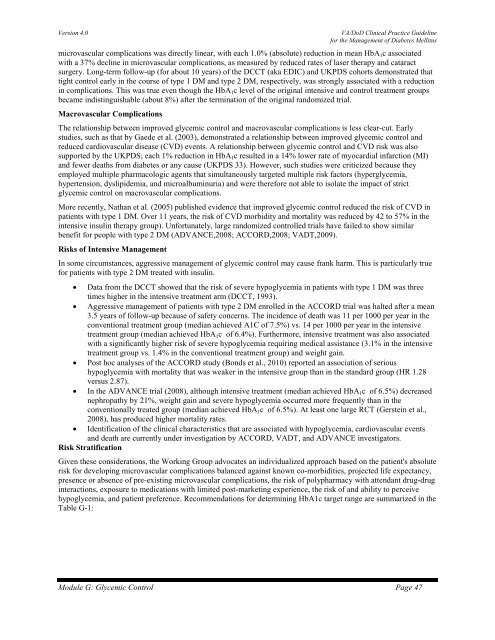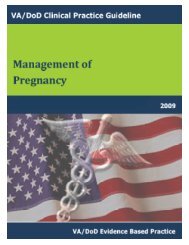DM Full Guideline (2010) - VA/DoD Clinical Practice Guidelines Home
DM Full Guideline (2010) - VA/DoD Clinical Practice Guidelines Home
DM Full Guideline (2010) - VA/DoD Clinical Practice Guidelines Home
You also want an ePaper? Increase the reach of your titles
YUMPU automatically turns print PDFs into web optimized ePapers that Google loves.
Version 4.0<br />
<strong>VA</strong>/<strong>DoD</strong> <strong>Clinical</strong> <strong>Practice</strong> <strong>Guideline</strong><br />
for the Management of Diabetes Mellitus<br />
microvascular complications was directly linear, with each 1.0% (absolute) reduction in mean HbA 1 c associated<br />
with a 37% decline in microvascular complications, as measured by reduced rates of laser therapy and cataract<br />
surgery. Long-term follow-up (for about 10 years) of the DCCT (aka EDIC) and UKPDS cohorts demonstrated that<br />
tight control early in the course of type 1 <strong>DM</strong> and type 2 <strong>DM</strong>, respectively, was strongly associated with a reduction<br />
in complications. This was true even though the HbA 1 c level of the original intensive and control treatment groups<br />
became indistinguishable (about 8%) after the termination of the original randomized trial.<br />
Macrovascular Complications<br />
The relationship between improved glycemic control and macrovascular complications is less clear-cut. Early<br />
studies, such as that by Gaede et al. (2003), demonstrated a relationship between improved glycemic control and<br />
reduced cardiovascular disease (CVD) events. A relationship between glycemic control and CVD risk was also<br />
supported by the UKPDS; each 1% reduction in HbA 1 c resulted in a 14% lower rate of myocardial infarction (MI)<br />
and fewer deaths from diabetes or any cause (UKPDS 33). However, such studies were criticized because they<br />
employed multiple pharmacologic agents that simultaneously targeted multiple risk factors (hyperglycemia,<br />
hypertension, dyslipidemia, and microalbuminuria) and were therefore not able to isolate the impact of strict<br />
glycemic control on macrovascular complications.<br />
More recently, Nathan et al. (2005) published evidence that improved glycemic control reduced the risk of CVD in<br />
patients with type 1 <strong>DM</strong>. Over 11 years, the risk of CVD morbidity and mortality was reduced by 42 to 57% in the<br />
intensive insulin therapy group). Unfortunately, large randomized controlled trials have failed to show similar<br />
benefit for people with type 2 <strong>DM</strong> (AD<strong>VA</strong>NCE,2008; ACCORD,2008; <strong>VA</strong>DT,2009).<br />
Risks of Intensive Management<br />
In some circumstances, aggressive management of glycemic control may cause frank harm. This is particularly true<br />
for patients with type 2 <strong>DM</strong> treated with insulin.<br />
• Data from the DCCT showed that the risk of severe hypoglycemia in patients with type 1 <strong>DM</strong> was three<br />
times higher in the intensive treatment arm (DCCT, 1993).<br />
• Aggressive management of patients with type 2 <strong>DM</strong> enrolled in the ACCORD trial was halted after a mean<br />
3.5 years of follow-up because of safety concerns. The incidence of death was 11 per 1000 per year in the<br />
conventional treatment group (median achieved A1C of 7.5%) vs. 14 per 1000 per year in the intensive<br />
treatment group (median achieved HbA 1 c of 6.4%). Furthermore, intensive treatment was also associated<br />
with a significantly higher risk of severe hypoglycemia requiring medical assistance (3.1% in the intensive<br />
treatment group vs. 1.4% in the conventional treatment group) and weight gain.<br />
• Post hoc analyses of the ACCORD study (Bonds et al., <strong>2010</strong>) reported an association of serious<br />
hypoglycemia with mortality that was weaker in the intensive group than in the standard group (HR 1.28<br />
versus 2.87).<br />
• In the AD<strong>VA</strong>NCE trial (2008), although intensive treatment (median achieved HbA 1 c of 6.5%) decreased<br />
nephropathy by 21%, weight gain and severe hypoglycemia occurred more frequently than in the<br />
conventionally treated group (median achieved HbA 1 c of 6.5%). At least one large RCT (Gerstein et al.,<br />
2008), has produced higher mortality rates.<br />
• Identification of the clinical characteristics that are associated with hypoglycemia, cardiovascular events<br />
and death are currently under investigation by ACCORD, <strong>VA</strong>DT, and AD<strong>VA</strong>NCE investigators.<br />
Risk Stratification<br />
Given these considerations, the Working Group advocates an individualized approach based on the patient's absolute<br />
risk for developing microvascular complications balanced against known co-morbidities, projected life expectancy,<br />
presence or absence of pre-existing microvascular complications, the risk of polypharmacy with attendant drug-drug<br />
interactions, exposure to medications with limited post-marketing experience, the risk of and ability to perceive<br />
hypoglycemia, and patient preference. Recommendations for determining HbA1c target range are summarized in the<br />
Table G-1:<br />
Module G: Glycemic Control Page 47
















